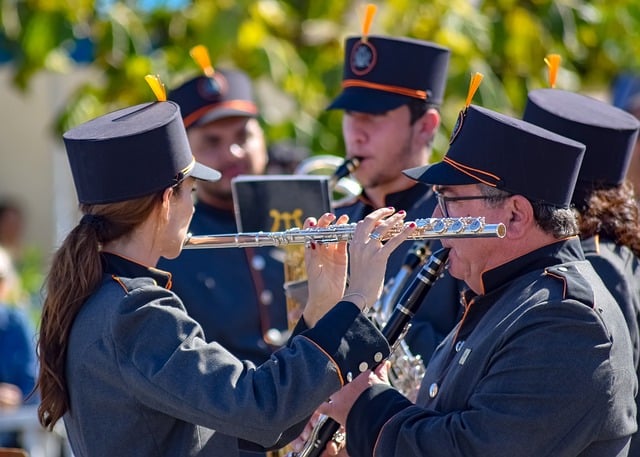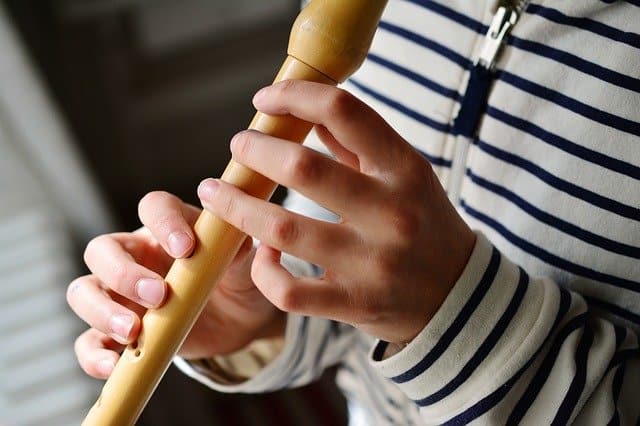How to Practice Flute Effectively
Every musician presumably wants to get the most out of their practice. This is a general guide based on my personal experience to practicing flute in a way that will help you grow as a musician, though the information here may help musicians who play other instruments as well.
Ideally, flute practice should involve harmonics, long tones, scales, and pieces of music that match your ability level. Conclude your practice with something that you enjoy to keep yourself motivated.
I consider these five elements (harmonics, long tones, scales, pieces, and something you enjoy) to be the most important elements of an effective practice session. While there are certainly other things that you can work on while practicing, I find that these five tend to help both me and my peers improve quickly and get the most out of practicing.
Below is an overview of how I recommend structuring a practice session depending on how much time you’re able to practice each day, as well as the basics of what to practice. I’m going to go through each section of the routine, and offer some general tips to practicing effectively.

The Practice Routine
Step 1: Harmonics
I recommend starting out your practice session with harmonics because they get you accustomed to the kind of lip movement that is required to play the flute while also helping you gain control of the upper register.
In practice, this involves using the fingering a low note while using your lips and airstream to produce a higher pitch. These are especially important on flute because the kind of lip movement that is needed to play harmonics is the exact same as is needed to be able to play high notes on the flute (which are, in fact, harmonics).
This means that harmonics are the most important practice to gain control of the high notes on flute. Starting out with harmonics at the beginning of each practice session will improve your control over high notes for the rest of the session, allowing you to get into the habit of consistently hitting high notes.
How to practice harmonics
If you are just starting out with harmonics, try the following: use the fingering a low C, but try to produce a pitch that is an octave higher. In the exercise below, the lower note represents the fingering you should use, while the top note represents the pitch you should hear.
When you practice harmonics, you want to make sure that you are adjusting pitch entirely through your lip movement, and not by changing the speed of your airstream. The emphasis should be on making sure that you have control over the pitch, and that at no point does it crack or squawk as you make adjustments.
If you can use the same low C fingering while having control over the pitch that is produced, then you are getting the hang of harmonics. You can also repeat the exercise using the fingering for low D E-flat, E, etc. Practicing this daily will give you much greater control over your upper register, and it makes for a great start to any practice routine.
Step 2: Long tones
After practicing harmonics, I recommend moving on to long tones. This involves playing and holding a note long enough so that you are able to really listen to it. When you play long tones, you will generally have two goals: you want it to sound good, and you want it to be in tune. A good sound and intonation are easiest to achieve on long held notes, so naturally long tones are the ideal way to practice these things.
Long tones are still a part of “warming up”, just like harmonics. Whereas harmonics are aimed at gaining control of the upper register, however, long tones are aimed at gaining control over your sound and intonation. I generally use them early on in a practice session because they enable me to have better control over my sound for the remainder of my practice time. Of course, sounding good also becomes easier overall as you practice them more, not just for the remainder of the individual session.
How to practice long tones
There is no one specific way to practice long tones. In large part, the way that you practice them depends on what notes you feel you need to work on the most. As a starting point, however, I recommend playing and holding either a C5 or B5 (these are the C and B in about the middle of the treble clef staff). These are the most stable notes on the flute, and are the most likely to sound good. The goal is to make these notes sound as brilliant as possible. You might be surprised by how much you can gain from playing a single note!
If you can get your C5 and B5 to sound beautiful, then you can start working your way into the lower register of the flute. These notes start to use the full length of the flute and as such tend to be less stable. They are more difficult to produce a good sound on, but practicing your C5 and B5 will create a good foundation for them. It may take a large amount of practice to get the lowest notes on the flute to sound fantastic, but it is always time well-spent to focus on them.
Additionally, make sure that you are checking each pitch with a tuner. One of the benefits of playing long tones is that they give you an opportunity to work on intonation as well as tone. Try using your lips to adjust the pitch as you check with your tuner, so that you can work toward playing perfectly in tune.
The biggest mistake that can be made with long tones is to play them mindlessly. The benefit from them comes from concentrating on your sound and tuning. It is easy to play a note without caring about how it sounds; it is more difficult to focus on making one note sound perfect. If you can play long tones every day with a reasonable amount of focus, you will likely find improvements both in the effectiveness of your practice as well as in your sound and intonation.
Step 3: Scales
Scales are the fundamental practices to be able to play complicated passages in music. This is the case for every instrument, and is just as true for flute. The purpose of practicing scales is to memorize patterns which recur in lots of music, effectively making it easier for you to play music in the future.
Some ways of practicing scales are better than others. To get the most out of your scales, I recommend always practicing scales with a metronome, practicing them over your full range, and starting them out slowly. You might also consider practicing other scale patterns, such as thirds.
Playing scales with a metronome is necessary because it ensures that you play them evenly. It is easy to accidentally speed up or slow down while playing a difficult part of a scale, and using a metronome is an easy way to catch yourself when you inevitably do so. It is also easier to avoid bad habits if you start the scales out at a slow tempo. Remember, scales are only helpful to the extent that you can play them correctly. Starting them out slowly gives you the chance to build the correct muscle memory so that you can eventually speed them up.
I recommend practicing scales over your full range because you will inevitably encounter difficult passages in the upper and lower registers of your instrument, and scales are the best habit to prepare yourself for that. Many people only play scales over one or two octaves, but this leaves them without the technique to play complex passages over the full range of their instrument.
Step 4: Pieces and etudes
This is where I recommend spending the largest portion of your practice time. While the above exercises are important, nothing will improve your playing as much as working on a specific piece or etude.
Ideally you should select a piece or etude that matches your skill level. This takes some degree of judgement, and having a teacher is especially helpful here in particular. Listening to a variety of flute music is a good start, because it allows you to get a sense of what pieces exist and what your preferences are. It is best to select a piece which you like, as it may otherwise be difficult to stay motivated to practice.
The first thing to do when you are looking at a new piece of music is to identify the key so that you know what scales and chords to expect. Look through the music or any scales or broken chords. If you regularly practice your scales, these sections will become easy.
If there are any difficult rhythms, then make sure you mentally work them out before you play them. You don’t want to train yourself to play them (or hear them) incorrectly, so take your time and make sure that you get the rhythm right the first time that you play it.
Make sure that you go through the piece slowly. Take it in chunks, and start out at a slow tempo. Using a metronome is just as useful here because it allows you to be sure that you are keeping a consistent tempo. Unlike in scales, however, you also need to consider dynamics, articulations (though scales can be played with specific articulations), and vibrato. Again, it is best to have a teacher to critique you on these elements.
Step 5: Playing something you enjoy
It is nice to have time at the end of a practice section to revisit old pieces, improvise, or play whatever else you might be interested in. Playing an instrument is meant to be fun, so you might as well dedicate a portion of your practice time to playing something that you enjoy.
Other than just being fun, this portion of your practice time holds another important purpose. Specifically, it gives you time to become generally more familiar with your instrument and to polish your abilities. If you choose to spend this time improvising, for instance, then you will gain an intuitive understanding of how to play by ear in a way that you might otherwise not from just reading sheet music. Alternatively, you might decide to revisit pieces of music that you’ve played in the past. This is also beneficial in that it strengthens your repertoire and allows you to gain an additional familiarity with those pieces to make them feel effortless.
The most important reason to play something you enjoy, however, is to ensure that you stay motivated to practice in the future. Practice can only be effective if you do it consistently. This will help you make it into a consistent habit.
General Tips for Practicing
Aside from the routine I give above, here are some general tips to get the most out of your practice.
#1: Organize your space
You don’t want to get distracted while practicing. To that end, it is necessary to make sure that you organize the area that you are going to be practicing in a way that doesn’t require you to encounter distractions. Have your materials (such as your music, metronome, pencil, tuner, perhaps a glass of water) all there at the beginning of your practice session so that you do not have to get up to get those things later.
If you aren’t using your phone as a tuner or metronome, I highly recommend turning it off (or at least turning off notifications) so that it does not compete for your attention as you are practicing. Being highly focused makes a big difference.
#2: Use proper posture
Slouching restricts your ability to breathe properly, and flute is an instrument which requires a lot of air to play well. When you practice, make sure that you are either standing or sitting upright with good posture.
Aside from allowing you to breathe more deeply, it is in fact easier to focus when you are sitting or standing tall. Both of these things are benefits which will allow you to get more out of your practice.
#3 Take breaks
This applies mostly if you are practicing for an hour or more. It is not productive to practice for extremely long periods of time without taking breaks. Playing an instrument can be both mentally and physically exhausting, and you will get more out of it if you take breaks.
I specifically recommend taking a 5 minute break every 25 or so minutes of practice. Consider, for instance, taking a break in between each section of the routine that I gave you above. During those breaks, try stretching, walking around, and focusing on things other than your music. This can help you come back to your music refreshed and better able to focus.
#4 Set goals for what you want to practice
Part of the reason that I use the routine I gave above is because it gives me a clear sense of what things I should focus on. It is much easier to accomplish something when you know exactly what it is that you want to accomplish. It may be worthwhile to say to yourself “I am going to practice only long tones for the next ten minutes with the goal of improving my tone and intonation.” You may find that simply setting the intention allows you to better concentrate on the task that you set for yourself.
From my experience, practicing without a clear set of goals can lead me to waste time trying to figure out what it is that I should work on, or lead me to practice things which I don’t actually need to work in. If you’ve had this kind of experience, I recommend getting into the habit of clearing stating to yourself (perhaps even in writing) what it is that you want to accomplish in your next practice session, or even over the course of multiple practice sessions (such as over the next week, month, or even several months of practice).
#5 Don’t forget to have fun
Part of the reason that I recommend saving some practice time for something you enjoy is to make sure that practicing doesn’t feel like a grind. Ideally, however, no part of the practice session should truly feel like a grind. If practice feels incredibly boring, that may be a sign that you need to change it in some way. This is a necessity for staying motivated, and as such the subject of how you can make your practice more enjoyable is worth thorough consideration.
It is critical that you find music to practice which you enjoy. If you happen to despise Mozart, then don’t play Mozart. Try to find a piece which you are passionate about so that you will have at least some intrinsic motivation to practice it.
Harmonics, scales, and long tones might all seem to be incredibly boring, but it is possible to find ways to make them interesting. Try viewing harmonics, for instance, as an opportunity to experiment and figure out what kinds of lip movements make your high notes respond better. Even long tones can become interesting if you completely concentrate your effort on producing a beautiful sound and playing in tune.
The bottom line is this: having fun during your practice is a necessity, not a luxury. Nobody can seriously dedicate themselves to an instrument that they aren’t enjoying. Make sure you are finding ways to make your practice interesting.
Conclusion
I firmly believe that effective flute practice is a product of an organized practice routine combined with good habits. My hope is that the suggestions I’ve given above offer some amount of help in making your flute practice better overall.
The advice that I’ve given may not work perfectly for everyone, so don’t forget to experiment with other things. There are plenty of other practice routines to try, and plenty of tips that I’m sure I forgot about. Part of the process of practicing is figuring out what works well for you.
If nothing else, though, I hope that you will give the above routine and tips a try, and perhaps use them as a starting point to develop the flute practice that is perfect for you.







